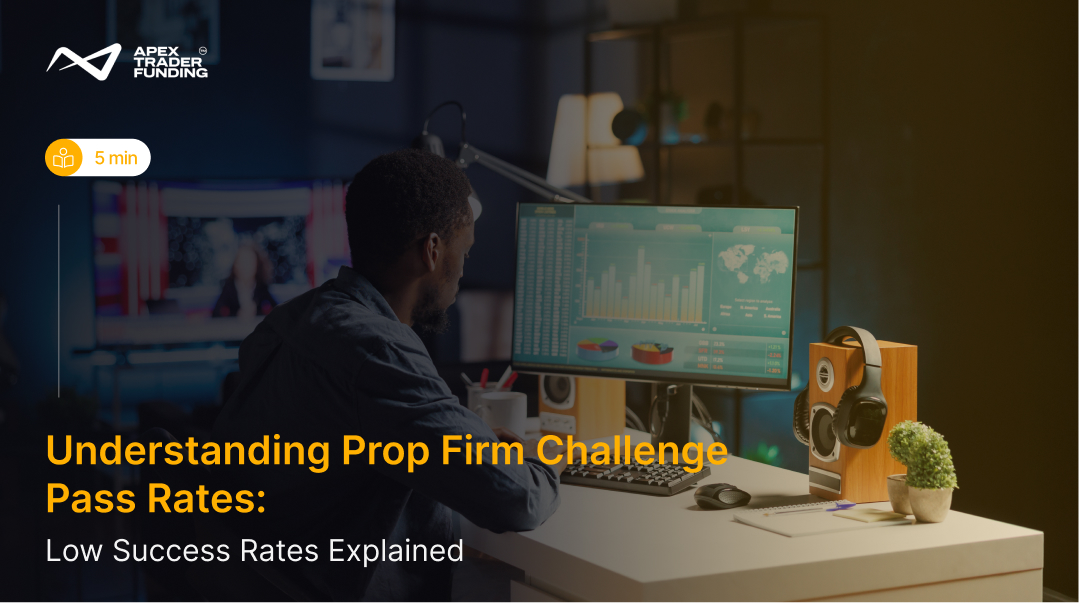
trading-tools-resources | 31-10-25
Prop firm challenges have become a modern gateway for traders seeking access to significant trading capital without risking their own funds. These evaluations test not only profitability but also discipline, consistency, and emotional control. Yet despite their popularity, the success rate stays low, not because the process is unfair, but because it rewards only those who combine skill, structure, and patience.
What Percentage of Traders Pass Prop Firm Challenges?
The percentage of traders who pass prop firm challenges is extremely small — typically under 5%, with some industry studies suggesting rates as low as 1% to 3%. These numbers can sound discouraging at first glance, but they show that most traders fail not because the system is unfair but because trading requires a blend of technical mastery and mental resilience that few fully develop.
Prop firms exist to identify those rare traders who can manage risk, stay consistent, and operate within strict limits. Passing a challenge is less about “winning” the market and more about proving that you can follow a structured, rule-based approach over time.
Average Pass and Retention Rates Across Prop Firms
These figures vary between firms and depend on the difficulty level of each program. Firms with one-step evaluations may have slightly higher pass rates, while multi-step or time-restricted models tend to be more demanding.
What do These Numbers Really Mean?
The low pass rate highlights how prop firm challenges are structured to reward consistency, patience, and genuine trading ability. Prop firms don’t expect perfection, they expect process. Their rules mirror what real institutional risk desks follow daily like measured exposure, consistency over time, and strict drawdown control.
In essence, prop firms aren’t designed to reward lucky traders — they reward repeatable decision-making that can survive months or years of volatile markets. Passing a challenge is proof that you can operate like a professional within structure, not emotion.
“Passing a prop firm challenge isn’t about beating the market — it’s about mastering yourself under rules that mimic the real world.”

Why the Pass Rate Is So Low?
Several factors contribute to the small percentage of traders who make it through the evaluation process.
1. Strict Risk and Rule Parameters
Every prop firm challenge comes with boundaries — profit targets, daily loss caps, trailing drawdowns, and consistency metrics. Even one violation, such as exceeding the loss limit by a few dollars, can result in immediate disqualification. These guardrails ensure that only disciplined, rule-oriented traders advance.
2. Consistency Over Flashy Wins
Many traders mistakenly believe that large profits will impress a firm. In reality, prop firms prefer steady performance. Consistency rules, such as limiting the percentage of total profits earned in one day, exist to identify traders who can sustain success, not gamble for it.
3. Emotional and Psychological Pressure
Challenges test psychology as much as skill. The ticking clock of time limits, combined with the fear of losing an evaluation fee, often pushes traders to make impulsive decisions — overtrading, moving stops, or chasing losses — behaviors that prop firms want to eliminate.
4. Lack of Preparation
Many participants enter evaluations without sufficient backtesting or practice. Trading a live or simulated prop challenge requires mastery of the firm’s rules, a well-tested system, and familiarity with real-time execution platforms — elements that can’t be improvised on the fly.
5. Complexity and Transparency Differences
While reputable firms are increasingly transparent, some still use confusing terminology or unclear policies. Missing a rule, misunderstanding a trailing drawdown, or misinterpreting a target can lead to accidental disqualification.
How to Improve Your Chances of Passing?
While the odds seem steep, traders who prepare strategically can dramatically improve their likelihood of success.
- Refine Risk Management: Never risk more than 1–2% of your account per trade. The ability to control downside is what keeps you in the game long enough to meet profit goals.
- Backtest and Forward Test Your Strategy: Validate your system under different market conditions using historical and demo environments.
- Trade Consistently: Avoid emotional trades and focus on a fixed setup or structure. Passing is often about repeating small gains, not chasing big moves.
- Understand Every Rule: Read the firm’s drawdown, loss, and payout terms in detail. Many traders fail due to technical misunderstandings, not poor trading.
- Simulate the Evaluation: Before paying for a challenge, practice under identical conditions using a demo account to ensure your plan performs within limits.
The Real Value of the Challenge
The evaluation process itself is a teacher. Even if you don’t pass the first time, the experience of trading with structure like tracking performance, limiting risk, and operating within strict rules is invaluable training for long-term success. Each attempt refines both your strategy and mindset.
Ultimately, the prop firm challenge is a professional filter, not a trap. It separates random risk-takers from systematic traders who treat trading like a business. Those who embrace that mindset stand among the small but growing group who turn the opportunity into funded success.
Final Thoughts
Only a small percentage of traders pass prop firm challenges — but those who do represent the discipline, patience, and skill that define true professionals. With preparation, structure, and a rule-driven strategy, the challenge becomes less of a barrier and more of a blueprint for growth.
Success doesn’t lie in beating the odds — it lies in building habits that make the odds irrelevant.
Passing a prop firm challenge is tough, but the right structure makes it achievable. Visit Apex Trader Funding and start your evaluation today with a 25K WealthCharts or 25K Tradovate account — your gateway to trading firm capital responsibly.
FAQs
Around 90 to 95 percent of traders fail funded challenges due to technical reasons such as hitting the maximum drawdown, exceeding daily loss limits, or not reaching the profit target within the evaluation period. Many also fail because they don’t fully understand the firm’s rules or mismanage position sizes during volatile market conditions.
Most prop traders work between 4 to 8 hours a day, depending on their trading style and the markets they trade. Some focus only on high-volatility sessions, such as the first few hours after a market opens, while others monitor positions throughout the trading day to manage risk and identify new setups.
Only about 3 to 5 percent of traders reach the payout stage at prop firms. Most traders fail during the evaluation or early funded phase due to rule violations or drawdowns. Those who do receive payouts typically demonstrate consistent profitability and strong adherence to risk parameters over time.
Related Blogs

trading-tools-resources | 28-08-25
How to Pass a Funded Trading Account?
Passing a funded trading account is often seen as the gateway to trading larger capital without risking personal savings. Yet...
Read more
trading-tools-resources | 02-09-25
Apex Trader Funding vs Topstep - Detailed Comparison
Among the many proprietary trading firms, Apex Trader Funding and Topstep are two of the most frequently compared by active...
Read more
trading-tools-resources | 04-09-25
Tradovate vs NinjaTrader in 2025: Futures Platforms Compared
When traders look for a futures trading platform, two names often dominate the conversation: Tradovate and NinjaTrader. Both platforms offer advanced...
Read more